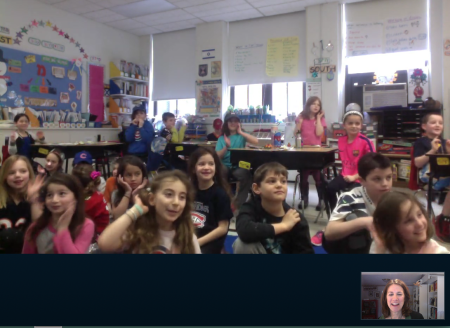Sarah Albee's Blog, page 13
March 23, 2015
Hickory Stick Signing
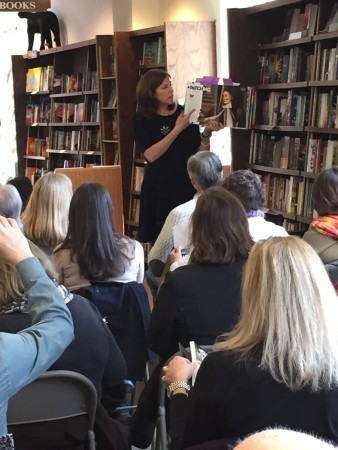 Yesterday I did a reading and signing at the beautiful Hickory Stick Bookshop in Washington, CT. It was a great turnout—including lots of grownups!!
Yesterday I did a reading and signing at the beautiful Hickory Stick Bookshop in Washington, CT. It was a great turnout—including lots of grownups!!
I was especially happy that so many people requested that I inscribe copies to sons, nephews, and grandsons. When the parent of a six-year-old boy told him the book was for him and his sister and showed him the cover, he said, “Awesome! A costume book!” Good enough for me.
If you are ever passing through northwest Connecticut, do stop in at the Hickory Stick. It’s a fantastic store.

Yeah, it’s the second day of spring.
The post Hickory Stick Signing appeared first on Sarah Albee.
March 19, 2015
Catherine’s Coup

Peter III
In the course of my research for my next book, which is about poison, I did some reading about Catherine the Great. I’d come across a reference that mentioned that her violent, sulky, deeply reviled husband, Peter III, had been poisoned.
Turns out, he probably wasn’t, but the story of their marriage is still pretty fascinating.
Catherine (née Sophia) was a young German princess who married Peter III in 1745, when she was 16 years old. He was 17, the proclaimed heir to the Russian throne, and the nephew of the empress Elizabeth (who was the daughter of Peter the Great). He would eventually become emperor, but would reign for just six months.
Their wedding was delayed when he contracted smallpox. Where before he had been blandly inoffensive looking, the first look Catherine got of him after his illness revealed that his face was horribly disfigured–swollen and pitted with pockmarks. His head had been shaved and he was wearing an enormous wig. She reacted with horror, which didn’t go over very well with him. Their marriage was loveless. Although they slept in the same bed for nine years, he did nothing but play with his huge collection of toy soldiers on top of the covers. During the day he spent most of his time dressing his servants in Prussian uniforms (Prussia was Russia’s enemy at the time) and leading them through military drills, playing screechily on his violin, and training his dogs inside the royal bedroom, which became a smelly kennel. He also drank a lot. He grew increasingly hostile toward his wife, and publicly threatened to banish her (or kill her) so that he could marry his mistress. He managed to alienate most of the clergy, guards, and nobles.
Catherine had garnered a lot of sympathetic friends at the court. In 1762, she staged a coup to overthrow him. He was “persuaded” to abdicate and did so. Years later, Frederick the Great said, “He allowed himself to be dethroned like a child being sent to bed.” Ouch.
He was made a state prisoner and housed in a summer estate, but no one really knew what to do with the deposed emperor, who still remained a threat. Catherine probably didn’t overtly declare to her close advisors how convenient Peter’s death might be to her political survival, but they may have read her mind.
On July 17, 1762, several close associates of Catherine’s invited the prisoner to dine with them. Everyone drank heavily. Then, whether planned or because a quarrel broke out, they fell on Peter and tried to smother him with a mattress. When he broke free, they caught him and strangled him with a scarf. It may have been a drunken brawl, or a premeditated act.

Catherine, eight years after Peter’s death
Catherine, horrified if not completely surprised, declared that the death was a medical tragedy. She ordered the body dissected to check for traces of poison. None was found. The doctors declared he had died of natural causes, probably an acute hemorrhoidal attack.
Sources:
Massie, Robert K. Catherine the Great: Portrait of a Woman. Random House, 2011
Henri Troyat. Catherine the Great . Meridian, 1980
The post Catherine’s Coup appeared first on Sarah Albee.
March 16, 2015
Tucson Festival of Books 2015
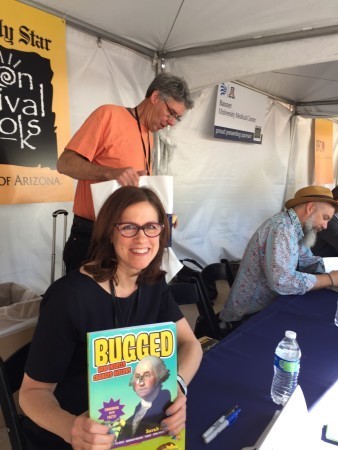 I’m heading home today from my weekend in Arizona at the Tucson Festival of Books. I ran a nonfiction writing workshop and was on a panel with three other amazing writers (Loree Griffin Burns, Helaine Becker, and Elizabeth Rusch) about science writing for kids. (I was the history-of-science representative on the panel.)
I’m heading home today from my weekend in Arizona at the Tucson Festival of Books. I ran a nonfiction writing workshop and was on a panel with three other amazing writers (Loree Griffin Burns, Helaine Becker, and Elizabeth Rusch) about science writing for kids. (I was the history-of-science representative on the panel.)
Some highlights:
Friday night I attended the Rock Bottom Remainders benefit concert. It’s a band made up of writers and it’s been in existence for twenty years, with a revolving cast of characters, and they raised over $50,000 to support literacy efforts in southern Arizona. The night we went the band included Amy Tan, Dave Barry, Scott Turow, Mitch Albom, Ridley Pearson, and multiple others. They were surprisingly good, and super-enthusiastic. The crowd (average age about 55) was rocking out.
Here are Loree and Jacqueline Davies. 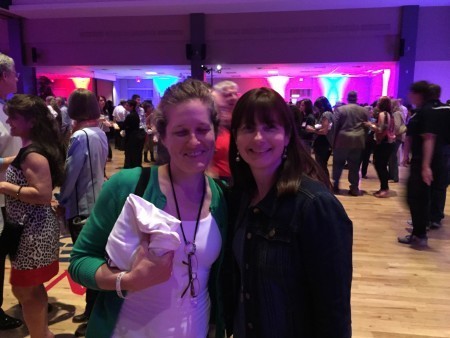

A picture that I shamelessly stole off of Jackie’s blog
Fun fact: Jackie and I were best friends in first and second grade before she *sob* moved away. We’ve finally reunited.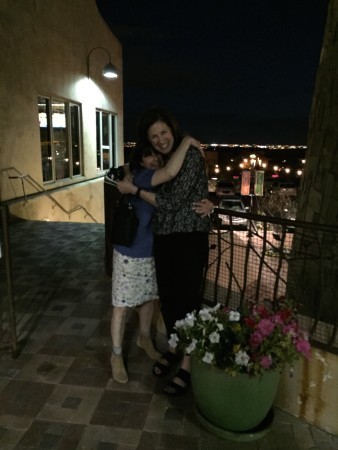 Tucson is a very cool town. Check out this rattlesnake overpass.
Tucson is a very cool town. Check out this rattlesnake overpass. After our workshops, at the next table over from me, Jo Knowles was signing, along with Emily Lockhart and Andrew Smith.
After our workshops, at the next table over from me, Jo Knowles was signing, along with Emily Lockhart and Andrew Smith.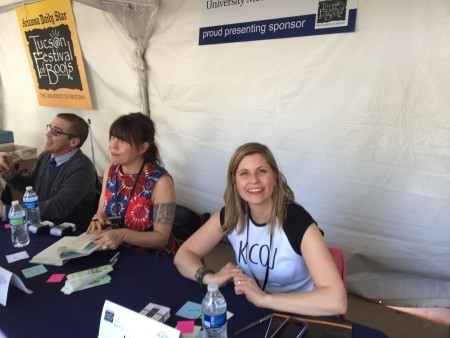

Me, Helaine, Loree, and Liz
At our signing, it was sunny and 85, and we could smell orange blossoms on the breeze.
The post Tucson Festival of Books 2015 appeared first on Sarah Albee.
March 12, 2015
Author Visit, Squadron Line Elementary School
Yesterday I had a delightful visit at the Squadron Line Elementary School in Simsbury, Connecticut. I couldn’t have asked for a lovelier reception, or a more beautiful school library in which to present, or a funnier librarian (Mr. Sepa) to introduce me, or a more enthusiastic group of fourth, fifth, and sixth grade kids.
Here I am, explaining where people dumped their chamber pots (out the window).
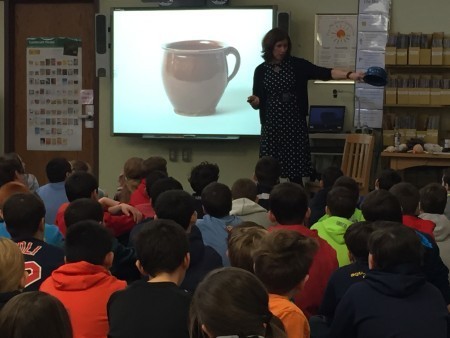 And here I am, talking about my new book, and showing the kids what these kids all have in common. I love the surprised gasp this one usually elicits!
And here I am, talking about my new book, and showing the kids what these kids all have in common. I love the surprised gasp this one usually elicits! Thanks to Jamie Sepa and Karin LeFranc for all the arrangements!
Thanks to Jamie Sepa and Karin LeFranc for all the arrangements!
The post Author Visit, Squadron Line Elementary School appeared first on Sarah Albee.
March 9, 2015
Candy Man

The toy is inside the plastic container, which is inside the chocolate egg. Come on, is this not the coolest toy/treat ever?
I don’t usually do obituaries on this blog, but I couldn’t let the recent passing of Michelle Ferrero go unacknowledged, as he made history in his own rite.
He was the candy maker who invented Tic Tacs, Nutella, and the chocolates called Ferrero Rocher. He died, one might say appropriately, this past Valentine’s day. With his vast riches and reclusive lifestyle, he was sort of a real-life version of Willy Wonka.
I remember when I was studying Italian in school, the first dialogue in my book was as follows:
Hai fame?
–Si! Ho fame.
Ecco Nutella!
He also invented Kinder eggs, which aren’t as familiar to Americans because they’re not sold in this country. They’re hollow chocolate eggs that contain an assemble-yourself toy inside, sort of like Cracker Jacks except that the toy is way more complicated and cool, or at least, it used to be. The toys have a zillion tiny parts to them, and they pose a choking hazard, which is why they’re not allowed to be sold here. Europeans appear to be less litigious.
I used to bring my kids Kinder eggs when I traveled to the Bologna book fair every year.
Riposi in pace.
The post Candy Man appeared first on Sarah Albee.
March 6, 2015
World Read Aloud Day 2015
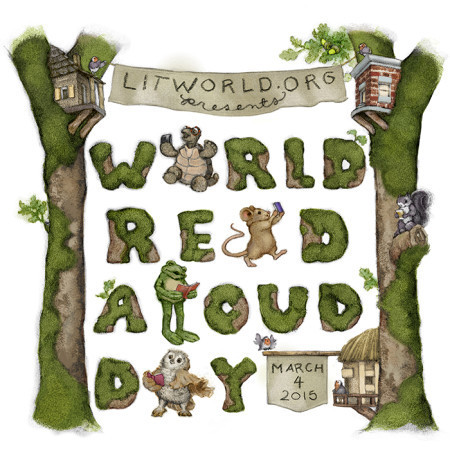 World Read Aloud Day is one of my favorite days of the year. And this year, due to (my) deadlines and travel, I expanded it a day before and a day after into World Read Aloud Day(s), skyping with multiple classrooms on Tuesday, Wednesday, and Thursday. Thanks to Ms. Barry’s fifth graders for kicking off the celebration on Tuesday! And on Wednesday (the official WRAD), I spoke with Ms. Merced’s classes in Chicago. A highlight, besides their wonderful questions, was their array of cool cheers. Here they are (posted with permission!):
World Read Aloud Day is one of my favorite days of the year. And this year, due to (my) deadlines and travel, I expanded it a day before and a day after into World Read Aloud Day(s), skyping with multiple classrooms on Tuesday, Wednesday, and Thursday. Thanks to Ms. Barry’s fifth graders for kicking off the celebration on Tuesday! And on Wednesday (the official WRAD), I spoke with Ms. Merced’s classes in Chicago. A highlight, besides their wonderful questions, was their array of cool cheers. Here they are (posted with permission!):
The “Firecracker” Cheer (imagine the sound effects that accompany it):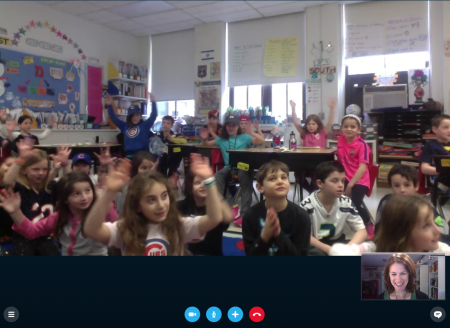
And the “Show Your Halo” Cheer: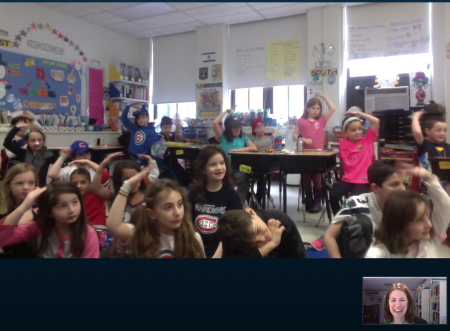
I then Skyped with Mr. Rosenblum’s class in Falmouth, Maine. They had some super-thoughtful questions, and we had a great discussion about writing: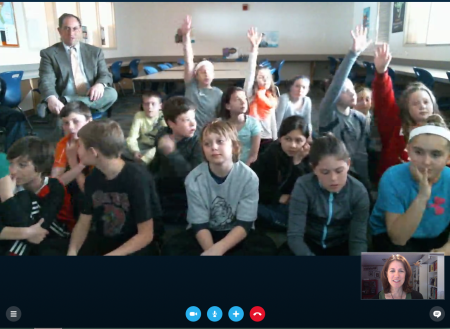
And for my last visit on WRAD, I did a “Live lesson” with Ms. Wissinger’s kids. Sorry that the visual is just me; they could see me on their end, and were typing questions that I answered. It was a blast!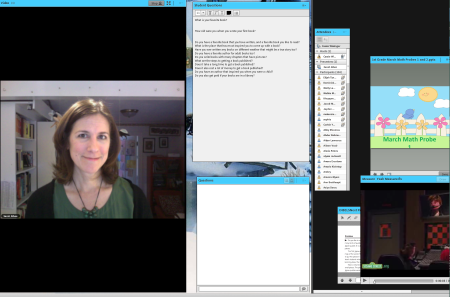
And finally, yesterday I skyped with third graders at Star Center Elementary School in Lake Geneva, Wisconsin. They kept me laughing with their questions and follow-up remarks!
Yep, it’s one of my favorite days weeks of the year.
The post World Read Aloud Day 2015 appeared first on Sarah Albee.
March 2, 2015
Wednesday, March 4th is World Read Aloud Day
Did you know that March 4th is World Read Aloud Day?
It’s organized by LitWorld as part of their Global Literacy Movement. You can read about it here.
 My schedule for Wednesday has been full for quite some time now, but if you are looking for an author who might still be available, you can click here to visit Kate Messner’s blog, where she maintains a list of authors available to Skype. Happy WRAD!
My schedule for Wednesday has been full for quite some time now, but if you are looking for an author who might still be available, you can click here to visit Kate Messner’s blog, where she maintains a list of authors available to Skype. Happy WRAD!
The post Wednesday, March 4th is World Read Aloud Day appeared first on Sarah Albee.
February 26, 2015
Ruff Times
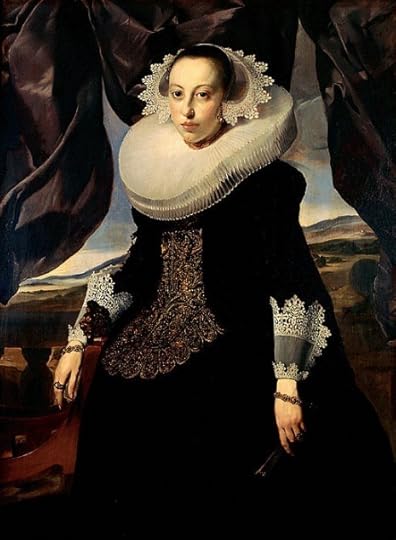 In my new book I have a section about ruff collars—those accordion-like, cartwheel-shaped gizmos that were in style from about 1530 to 1630. That’s a long time to be in fashion, expecially considering how incredibly ungainly and impractical (not to say unattractive) these things were. The Dutch wore them for even longer—they seemed to prefer being intentionally out of style. Even working people wore them, although theirs tended to be a much smaller version–because they had to work for a living.
In my new book I have a section about ruff collars—those accordion-like, cartwheel-shaped gizmos that were in style from about 1530 to 1630. That’s a long time to be in fashion, expecially considering how incredibly ungainly and impractical (not to say unattractive) these things were. The Dutch wore them for even longer—they seemed to prefer being intentionally out of style. Even working people wore them, although theirs tended to be a much smaller version–because they had to work for a living.
Making a ruff required huge skill and patience. The linen was pleated into folds in a figure eight pattern, using a “poking stick,” and creased with heated irons. By the 1560s, someone figured out how to make starch as a stiffener. Wheat was boiled to a goopy paste, spackled on, and brushed into every fold. The ruff was then dried in front of a fire, before the whole process was repeated. Then it had to be pinned onto a wire support (called an underpropper), which was in turn pinned to the neckline of the dress or other garment. This process could take hours. Even kids wore them.

This is a boy. Lord Arundel. You can tell by the shoes.
Ruffs were fragile. They drooped in wet weather. The bigger ones allowed the wearer virtually no freedom of movement. Members of the nobility wore huge ruffs to advertise their leisure status; the wearer was incapable of performing any physical labor. Spoons had to be made with longer handles to reach the person’s mouth.
Here’s Henry III of France. I’m pretty sure that’s a jewel, and not a botfly, on his head.
Just to see what it might have been like, I made a crude ruff out of cardboard and tried walking around with it. What a nightmare. You can’t see your feet—and I wasn’t wearing a floor-length farthingale. Here’s my husband, gamely modeling it for me. He’s a pretty good sport.


Sources: Liza Picard: Elizabeth’s London (125-6)
and Ewing, Dress and Undress (32)
The post Ruff Times appeared first on Sarah Albee.
February 23, 2015
Thanks, Southeast Elementary School!
Sometimes when I arrive at a school for an author visit, I have a feeling as soon as I step inside the building that it will be a great day. That’s what happened on Friday when I visited Southeast Elementary School in Mansfield, CT.
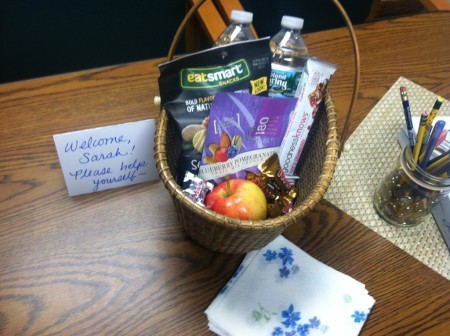 There were welcome posters hanging in the hallways, and this little basket of goodies awaiting me in the conference room, where I signed dozens and dozens of books. I spoke with three different groups, from PreK to fourth grade, and they were full of great questions that kept the discussions lively and fun.
There were welcome posters hanging in the hallways, and this little basket of goodies awaiting me in the conference room, where I signed dozens and dozens of books. I spoke with three different groups, from PreK to fourth grade, and they were full of great questions that kept the discussions lively and fun.
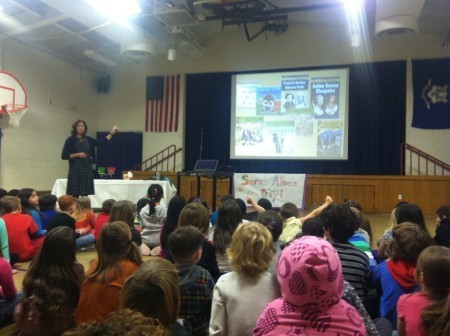 And as a special bonus, I got to have lunch with a classroom full of third and fourth graders, where we talked about favorite books, reading, writing, and playing basketball in Cairo (they’d read my website bio!).
And as a special bonus, I got to have lunch with a classroom full of third and fourth graders, where we talked about favorite books, reading, writing, and playing basketball in Cairo (they’d read my website bio!).
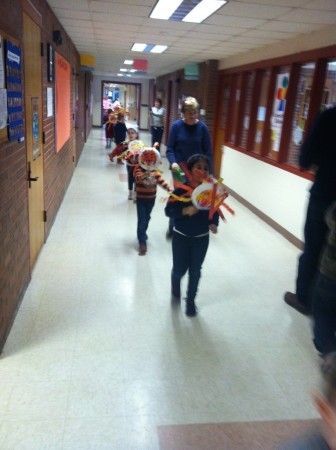 Possibly the cutest moment of my day? Just as I was leaving, I saw this looong parade of four-year-olds march past, celebrating Chinese New Year.
Possibly the cutest moment of my day? Just as I was leaving, I saw this looong parade of four-year-olds march past, celebrating Chinese New Year.
Thanks to Kelly Villar and her colleagues for the wonderful organizing and enthusiasm!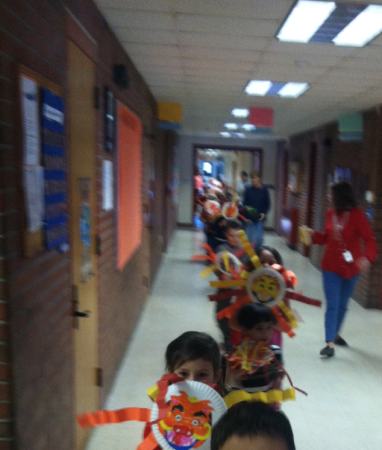
The post Thanks, Southeast Elementary School! appeared first on Sarah Albee.
February 19, 2015
Renaissance Selfies
In my last post I discussed Steven Johnson’s book How We Got to Now: Six Innovations That Made the Modern World, and I couldn’t resist another post about it. It’s such a cool book, if you haven’t read it.
In his chapter called “Glass,” Johnson describes how in the early fifteenth century, glassmakers in Murano figured out a way to combine their clear glass with an amalgam of tin and mercury to make a shiny, reflective surface: the mirror. Before mirrors were invented, few people had ever seen an accurate reflection of themselves. And with that advancement, another innovation co-evolved: self-portraits. Before 1400, Johnson points out, there were virtually none. But with the invention of mirrors, Renaissance artists suddenly began painting themselves, because for the first time, they could accurately capture the features of their own faces. Rembrandt painted forty self-portraits.
Here’s just a sampling:

Taddeo di Bartolo, 1401

Raphael, 1506

Tintoretto, 1547

Artemesia, 1615

Two of Rembrandt’s 40 selfies

The post Renaissance Selfies appeared first on Sarah Albee.

